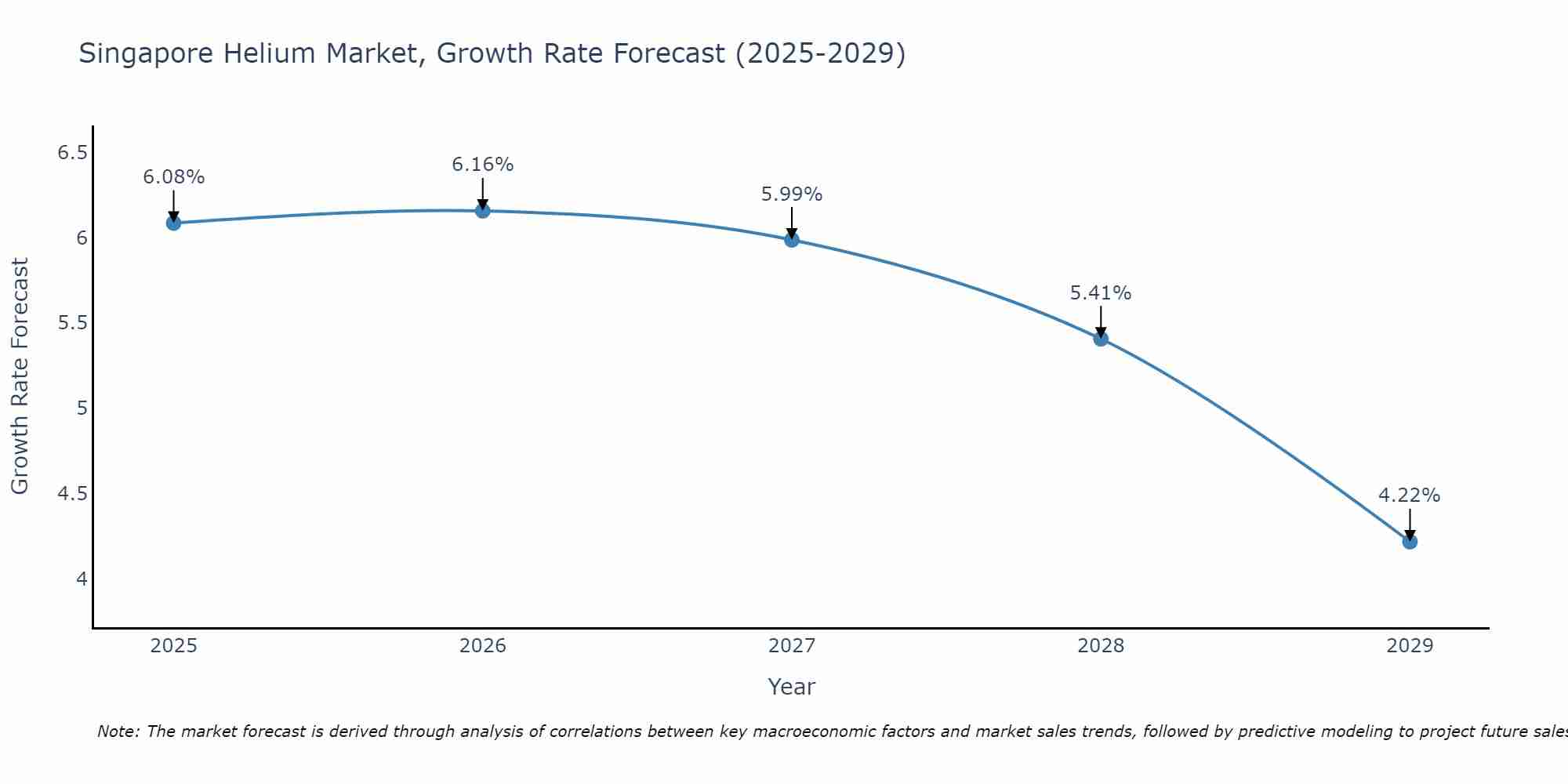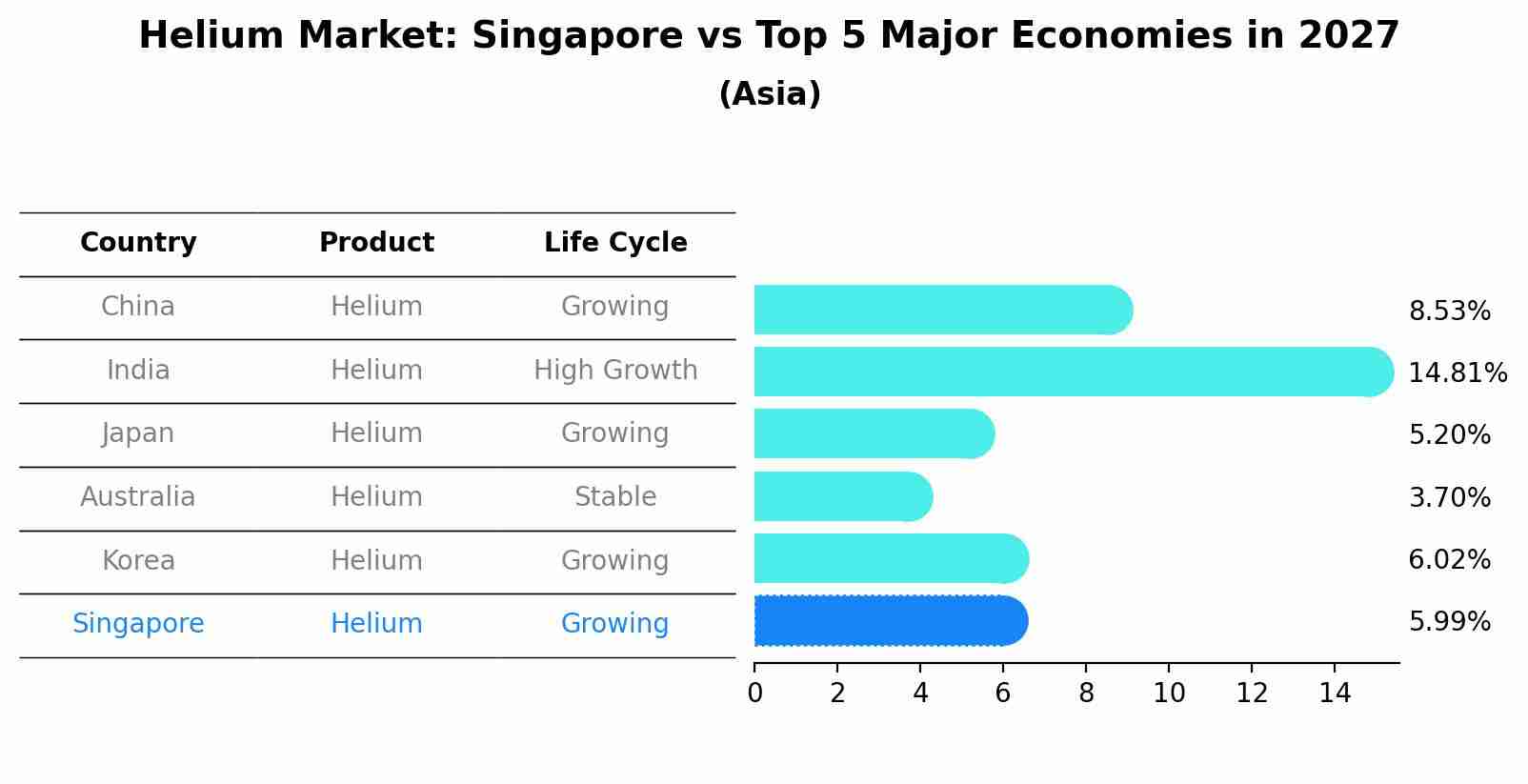Singapore Helium Market (2025-2031) Outlook | Industry, Companies, Revenue, Value, Trends, Growth, Share, Analysis, Forecast & Size
| Product Code: ETC087106 | Publication Date: Jun 2021 | Updated Date: Apr 2025 | Product Type: Report | |
| Publisher: 6Wresearch | Author: Ravi Bhandari | No. of Pages: 70 | No. of Figures: 35 | No. of Tables: 5 |
Singapore Helium Market Size Growth Rate
The Singapore Helium Market is projected to witness mixed growth rate patterns during 2025 to 2029. Growth accelerates to 6.16% in 2026, following an initial rate of 6.08%, before easing to 4.22% at the end of the period.

Helium Market: Singapore vs Top 5 Major Economies in 2027 (Asia)
Singapore's Helium market is anticipated to experience a growing growth rate of 5.99% by 2027, reflecting trends observed in the largest economy China, followed by India, Japan, Australia and South Korea.

Singapore Helium Market Synopsis
The Singapore helium market is relatively small but essential for various industries, such as healthcare, electronics, and aerospace. Helium is critical for cooling MRI machines and as a coolant in semiconductor manufacturing. Singapore largely depends on helium imports, making it susceptible to fluctuations in global helium supply and pricing. Given the global shortage of helium in recent years, the market outlook is driven by factors like helium production and distribution, geopolitical tensions affecting supply chains, and advances in helium recycling technologies. Companies in Singapore helium-related industries should closely monitor these factors for business continuity.
Drivers of the Market
The helium market in Singapore may see expansion owing to the gas`s critical role in various industries, especially in scientific research and medical applications. Helium is essential for cooling superconducting magnets in MRI machines and other high-tech devices. As healthcare infrastructure grows and research facilities expand in Singapore, the demand for helium is expected to rise. Additionally, the semiconductor manufacturing sector`s reliance on helium for cooling and purging applications further supports the market`s outlook.
Challenges of the Market
Singapore helium market confronts challenges related to helium scarcity. Helium is essential for various applications, especially in the medical and semiconductor sectors. The global helium supply is limited, and the market`s dependence on a few key producers can lead to pricing uncertainties and potential shortages. Finding alternative sources and promoting helium recycling is critical.
COVID-19 Impact on the Market
The helium market in Singapore is relatively niche but essential, primarily serving industries such as healthcare, electronics, and aerospace. The pandemic initially disrupted the supply of helium, affecting industries reliant on this gas. However, as vaccine distribution progressed and economies reopened, the demand for helium in healthcare applications, particularly in cooling systems for vaccine storage, increased. While the market experienced challenges during the pandemic, it is expected to stabilize and grow as these sectors recover and expand.
Key Players in the Market
In Singapore Helium Market Key Players include Linde plc, Air Products and Chemicals, Inc., Air Liquide S.A.
Key Highlights of the Report:
- Singapore Helium Market Outlook
- Market Size of Singapore Helium Market, 2024
- Forecast of Singapore Helium Market, 2031
- Historical Data and Forecast of Singapore Helium Revenues & Volume for the Period 2021-2031
- Singapore Helium Market Trend Evolution
- Singapore Helium Market Drivers and Challenges
- Singapore Helium Price Trends
- Singapore Helium Porter's Five Forces
- Singapore Helium Industry Life Cycle
- Historical Data and Forecast of Singapore Helium Market Revenues & Volume By Type for the Period 2021-2031
- Historical Data and Forecast of Singapore Helium Market Revenues & Volume By Liquid Helium for the Period 2021-2031
- Historical Data and Forecast of Singapore Helium Market Revenues & Volume By Gaseous Helium for the Period 2021-2031
- Historical Data and Forecast of Singapore Helium Market Revenues & Volume By End-users for the Period 2021-2031
- Historical Data and Forecast of Singapore Helium Market Revenues & Volume By Aerospace and Aircraft for the Period 2021-2031
- Historical Data and Forecast of Singapore Helium Market Revenues & Volume By Electronics and Semiconductors for the Period 2021-2031
- Historical Data and Forecast of Singapore Helium Market Revenues & Volume By Nuclear Power for the Period 2021-2031
- Historical Data and Forecast of Singapore Helium Market Revenues & Volume By Healthcare for the Period 2021-2031
- Historical Data and Forecast of Singapore Helium Market Revenues & Volume By Welding and Metal Fabrication for the Period 2021-2031
- Historical Data and Forecast of Singapore Helium Market Revenues & Volume By Other for the Period 2021-2031
- Historical Data and Forecast of Singapore Helium Market Revenues & Volume By Application for the Period 2021-2031
- Historical Data and Forecast of Singapore Helium Market Revenues & Volume By Breathing Mixes for the Period 2021-2031
- Historical Data and Forecast of Singapore Helium Market Revenues & Volume By Cryogenics for the Period 2021-2031
- Historical Data and Forecast of Singapore Helium Market Revenues & Volume By Leak Detection for the Period 2021-2031
- Historical Data and Forecast of Singapore Helium Market Revenues & Volume By Pressurizing and Purging for the Period 2021-2031
- Historical Data and Forecast of Singapore Helium Market Revenues & Volume By Welding for the Period 2021-2031
- Historical Data and Forecast of Singapore Helium Market Revenues & Volume By Controlled Atmosphere for the Period 2021-2031
- Historical Data and Forecast of Singapore Helium Market Revenues & Volume By Other for the Period 2021-2031
- Singapore Helium Import Export Trade Statistics
- Market Opportunity Assessment By Type
- Market Opportunity Assessment By End-users
- Market Opportunity Assessment By Application
- Singapore Helium Top Companies Market Share
- Singapore Helium Competitive Benchmarking By Technical and Operational Parameters
- Singapore Helium Company Profiles
- Singapore Helium Key Strategic Recommendations
Frequently Asked Questions About the Market Study (FAQs):
1 Executive Summary |
2 Introduction |
2.1 Key Highlights of the Report |
2.2 Report Description |
2.3 Market Scope & Segmentation |
2.4 Research Methodology |
2.5 Assumptions |
3 Singapore Helium Market Overview |
3.1 Singapore Country Macro Economic Indicators |
3.2 Singapore Helium Market Revenues & Volume, 2021 & 2031F |
3.3 Singapore Helium Market - Industry Life Cycle |
3.4 Singapore Helium Market - Porter's Five Forces |
3.5 Singapore Helium Market Revenues & Volume Share, By Type, 2021 & 2031F |
3.6 Singapore Helium Market Revenues & Volume Share, By End-users, 2021 & 2031F |
3.7 Singapore Helium Market Revenues & Volume Share, By Application, 2021 & 2031F |
4 Singapore Helium Market Dynamics |
4.1 Impact Analysis |
4.2 Market Drivers |
4.3 Market Restraints |
5 Singapore Helium Market Trends |
6 Singapore Helium Market, By Types |
6.1 Singapore Helium Market, By Type |
6.1.1 Overview and Analysis |
6.1.2 Singapore Helium Market Revenues & Volume, By Type, 2021-2031F |
6.1.3 Singapore Helium Market Revenues & Volume, By Liquid Helium, 2021-2031F |
6.1.4 Singapore Helium Market Revenues & Volume, By Gaseous Helium, 2021-2031F |
6.2 Singapore Helium Market, By End-users |
6.2.1 Overview and Analysis |
6.2.2 Singapore Helium Market Revenues & Volume, By Aerospace and Aircraft, 2021-2031F |
6.2.3 Singapore Helium Market Revenues & Volume, By Electronics and Semiconductors, 2021-2031F |
6.2.4 Singapore Helium Market Revenues & Volume, By Nuclear Power, 2021-2031F |
6.2.5 Singapore Helium Market Revenues & Volume, By Healthcare, 2021-2031F |
6.2.6 Singapore Helium Market Revenues & Volume, By Welding and Metal Fabrication, 2021-2031F |
6.2.7 Singapore Helium Market Revenues & Volume, By Other, 2021-2031F |
6.3 Singapore Helium Market, By Application |
6.3.1 Overview and Analysis |
6.3.2 Singapore Helium Market Revenues & Volume, By Breathing Mixes, 2021-2031F |
6.3.3 Singapore Helium Market Revenues & Volume, By Cryogenics, 2021-2031F |
6.3.4 Singapore Helium Market Revenues & Volume, By Leak Detection, 2021-2031F |
6.3.5 Singapore Helium Market Revenues & Volume, By Pressurizing and Purging, 2021-2031F |
6.3.6 Singapore Helium Market Revenues & Volume, By Welding, 2021-2031F |
6.3.7 Singapore Helium Market Revenues & Volume, By Controlled Atmosphere, 2021-2031F |
7 Singapore Helium Market Import-Export Trade Statistics |
7.1 Singapore Helium Market Export to Major Countries |
7.2 Singapore Helium Market Imports from Major Countries |
8 Singapore Helium Market Key Performance Indicators |
9 Singapore Helium Market - Opportunity Assessment |
9.1 Singapore Helium Market Opportunity Assessment, By Type, 2021 & 2031F |
9.2 Singapore Helium Market Opportunity Assessment, By End-users, 2021 & 2031F |
9.3 Singapore Helium Market Opportunity Assessment, By Application, 2021 & 2031F |
10 Singapore Helium Market - Competitive Landscape |
10.1 Singapore Helium Market Revenue Share, By Companies, 2024 |
10.2 Singapore Helium Market Competitive Benchmarking, By Operating and Technical Parameters |
11 Company Profiles |
12 Recommendations |
13 Disclaimer |
- Single User License$ 1,995
- Department License$ 2,400
- Site License$ 3,120
- Global License$ 3,795
Search
Thought Leadership and Analyst Meet
Our Clients
Related Reports
- Canada Oil and Gas Market (2026-2032) | Share, Segmentation, Value, Industry, Trends, Forecast, Analysis, Size & Revenue, Growth, Competitive Landscape, Outlook, Companies
- Germany Breakfast Food Market (2026-2032) | Industry, Share, Growth, Size, Companies, Value, Analysis, Revenue, Trends, Forecast & Outlook
- Australia Briquette Market (2025-2031) | Growth, Size, Revenue, Forecast, Analysis, Trends, Value, Share, Industry & Companies
- Vietnam System Integrator Market (2025-2031) | Size, Companies, Analysis, Industry, Value, Forecast, Growth, Trends, Revenue & Share
- ASEAN and Thailand Brain Health Supplements Market (2025-2031) | Strategy, Consumer Insights, Analysis, Investment Trends, Opportunities, Growth, Size, Share, Industry, Revenue, Segments, Value, Segmentation, Supply, Forecast, Restraints, Outlook, Competition, Drivers, Trends, Demand, Pricing Analysis, Competitive, Strategic Insights, Companies, Challenges
- ASEAN Bearings Market (2025-2031) | Strategy, Consumer Insights, Analysis, Investment Trends, Opportunities, Growth, Size, Share, Industry, Revenue, Segments, Value, Segmentation, Supply, Forecast, Restraints, Outlook, Competition, Drivers, Trends, Demand, Pricing Analysis, Competitive, Strategic Insights, Companies, Challenges
- Europe Flooring Market (2025-2031) | Outlook, Share, Industry, Trends, Forecast, Companies, Revenue, Size, Analysis, Growth & Value
- Saudi Arabia Manlift Market (2025-2031) | Outlook, Size, Growth, Trends, Companies, Industry, Revenue, Value, Share, Forecast & Analysis
- Uganda Excavator, Crane, and Wheel Loaders Market (2025-2031) | Strategy, Consumer Insights, Analysis, Investment Trends, Opportunities, Growth, Size, Share, Industry, Revenue, Segments, Value, Segmentation, Supply, Forecast, Restraints, Outlook, Competition, Drivers, Trends, Demand, Pricing Analysis, Competitive, Strategic Insights, Companies, Challenges
- Rwanda Excavator, Crane, and Wheel Loaders Market (2025-2031) | Strategy, Consumer Insights, Analysis, Investment Trends, Opportunities, Growth, Size, Share, Industry, Revenue, Segments, Value, Segmentation, Supply, Forecast, Restraints, Outlook, Competition, Drivers, Trends, Demand, Pricing Analysis, Competitive, Strategic Insights, Companies, Challenges
Industry Events and Analyst Meet
Whitepaper
- Middle East & Africa Commercial Security Market Click here to view more.
- Middle East & Africa Fire Safety Systems & Equipment Market Click here to view more.
- GCC Drone Market Click here to view more.
- Middle East Lighting Fixture Market Click here to view more.
- GCC Physical & Perimeter Security Market Click here to view more.
6WResearch In News
- Doha a strategic location for EV manufacturing hub: IPA Qatar
- Demand for luxury TVs surging in the GCC, says Samsung
- Empowering Growth: The Thriving Journey of Bangladesh’s Cable Industry
- Demand for luxury TVs surging in the GCC, says Samsung
- Video call with a traditional healer? Once unthinkable, it’s now common in South Africa
- Intelligent Buildings To Smooth GCC’s Path To Net Zero


















